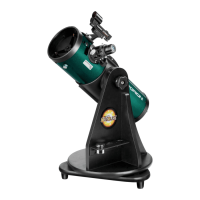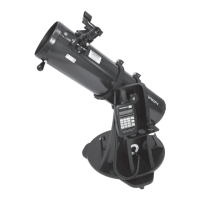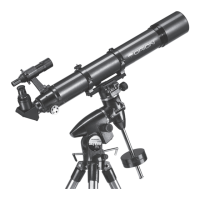Do you have a question about the Orion starBlast 4.5 EQ and is the answer not in the manual?
Ensures smooth movement by balancing the optical tube on both axes.
Details how to achieve a sharp image using the focuser and eyepiece.
Aligns the reflex sight's red dot with the telescope's eyepiece view.
Aligns the mount's R.A. axis with Earth's rotational axis for tracking.
Allows fine adjustment of telescope position for centering objects.
Explains how to follow celestial objects using the R.A. axis.
Explains how setting circles help locate celestial objects by coordinates.
Calibrates the R.A. setting circle for accurate object location.
Guides users on locating celestial objects using calibrated setting circles.
Addresses common beginner confusion on aiming the telescope.
Introduces the collimating cap and center mark for precise mirror alignment.
Details the process for adjusting the secondary mirror's position.
Describes the final adjustment of the primary mirror for optical alignment.
Explains how to verify optical alignment using a star test.
Provides guidance on selecting optimal locations for stargazing.
Discusses atmospheric conditions affecting astronomical viewing quality.
Explains the need for telescope acclimation to ambient temperature.
Advises on the process of adapting eyes to darkness for better viewing.
Explains how to calculate magnification and choose eyepieces.
Sets expectations for observable celestial objects and their appearance.
Details observing the Moon and its features.
Guides on finding and observing planets in the night sky.
Explains safe solar observation with an optional filter.
Describes observing stars and identifying colors and double stars.
Guides on observing faint objects like nebulas and galaxies.
Provides instructions for safely cleaning telescope eyepieces and sights.
Details the procedure for cleaning the primary and secondary mirrors.
Ensures smooth movement by balancing the optical tube on both axes.
Details how to achieve a sharp image using the focuser and eyepiece.
Aligns the reflex sight's red dot with the telescope's eyepiece view.
Aligns the mount's R.A. axis with Earth's rotational axis for tracking.
Allows fine adjustment of telescope position for centering objects.
Explains how to follow celestial objects using the R.A. axis.
Explains how setting circles help locate celestial objects by coordinates.
Calibrates the R.A. setting circle for accurate object location.
Guides users on locating celestial objects using calibrated setting circles.
Addresses common beginner confusion on aiming the telescope.
Introduces the collimating cap and center mark for precise mirror alignment.
Details the process for adjusting the secondary mirror's position.
Describes the final adjustment of the primary mirror for optical alignment.
Explains how to verify optical alignment using a star test.
Provides guidance on selecting optimal locations for stargazing.
Discusses atmospheric conditions affecting astronomical viewing quality.
Explains the need for telescope acclimation to ambient temperature.
Advises on the process of adapting eyes to darkness for better viewing.
Explains how to calculate magnification and choose eyepieces.
Sets expectations for observable celestial objects and their appearance.
Details observing the Moon and its features.
Guides on finding and observing planets in the night sky.
Explains safe solar observation with an optional filter.
Describes observing stars and identifying colors and double stars.
Guides on observing faint objects like nebulas and galaxies.
Provides instructions for safely cleaning telescope eyepieces and sights.
Details the procedure for cleaning the primary and secondary mirrors.
| primary mirror diameter | 4.5" (114mm) |
|---|---|
| effective focal length | 450mm |
| focal ratio | f/3.9 |
| minor axis of secondary mirror | 1.3" (34mm) |
| mirror coatings | Aluminum with silicon dioxide (SiO2) overcoat |
| focuser type | Rack-and-pinion |
|---|---|
| eyepiece size | 1.25" |
| eyepiece magnification with 15mm eyepiece | 30x |
| eyepiece magnification with 6mm eyepiece | 75x |
| eyepiece coatings | Fully coated with multi-coatings |
| finder scope | EZ Finder II reflex sight |
|---|---|
| mount type | EQ-1, German equatorial |
| tripod material | Aluminum |
| total instrument weight | 17 lbs |












